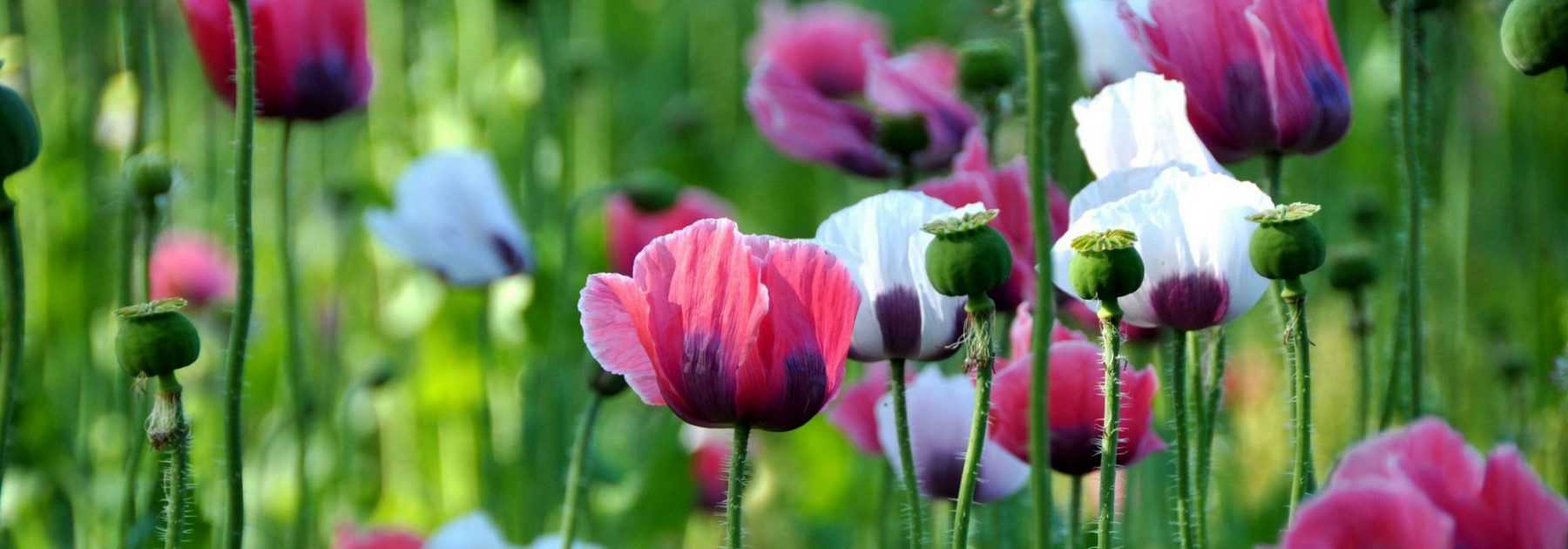
Annual Poppies and Corn Poppies: Sowing, Growing and Care
Contents
Annual poppies in a nutshell
- Annual poppies brighten gardens with their lavish colours from May to July
- Their seed pods make stunning additions to dried flower arrangements
- Easy to grow, they shoot up quickly and thrive in sunny spots with well-drained soil
- To our delight, they self-seed spontaneously in the most unexpected places!
- There’s an extensive choice of colours and forms available
Our expert's word
Annual poppies are undoubtedly among our easiest wild plants to grow. Hardy, they require minimal maintenance. Growing rapidly, they produce a dazzling floral display for a single season. Their rounded corollas with silky, crinkled petals can showcase every colour and form. After flowering, their decorative seed pods will scatter countless seeds on the wind. Playful and unpredictable, they then colonise the most unlikely corners of the garden.
Whether corn poppies, garden poppies or Californian poppies, they thrive in sunny spots with well-drained soil, even in poor conditions. Extremely hardy, they can withstand temperatures down to -25°C depending on the variety, and are undemanding.
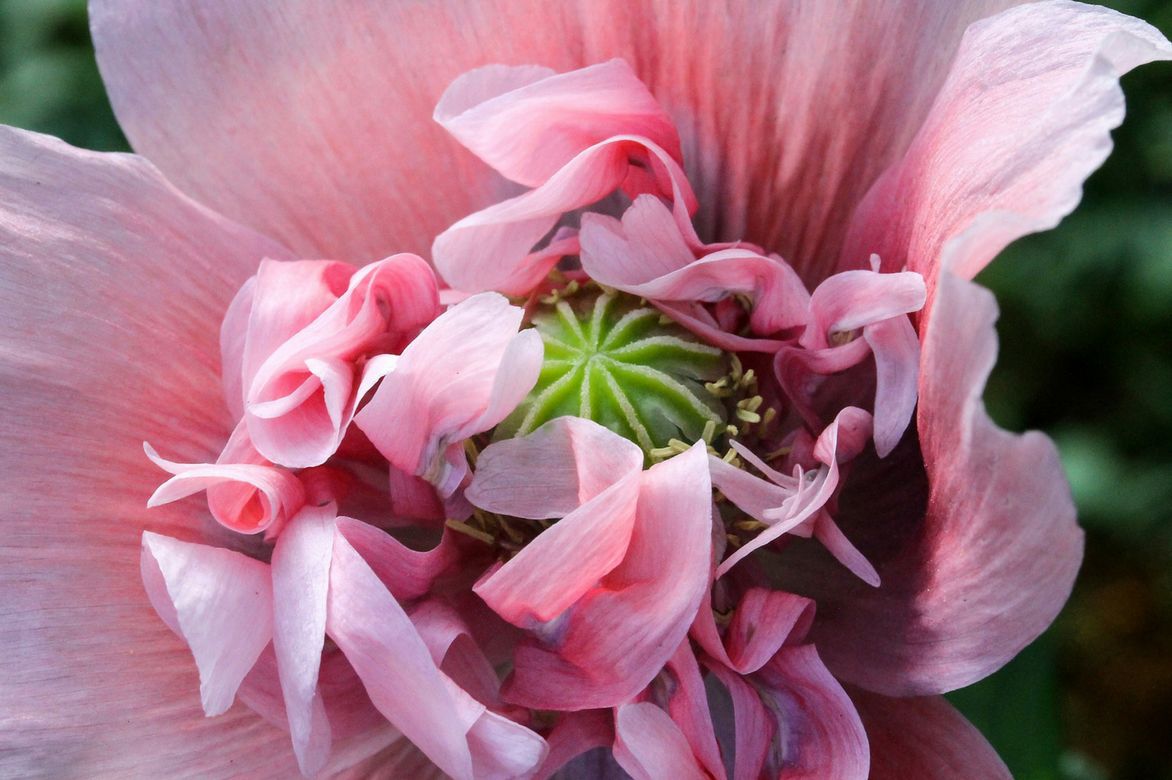
Fluffy heart of an opium poppy.
Annual poppies are invaluable for gardeners because they provide a colourful transition between spring and midsummer flowering. They beautifully fill seasonal gaps in borders, as well as neglected spots in the garden. Especially since the choice is vast: pink or white corn poppies, peony-flowered poppies for a romantic corner, multi-petalled poppies with more or less undulate blooms forming plump pompons, tattered corollas, bicoloured varieties…
Poppies have their place everywhere: in natural gardens or wildflower meadows of course, where they mingle gracefully with grasses and other annuals, but they also casually brighten up urban or formal gardens with their mischievous charm. Their single flowers bring freshness and a natural touch to contemporary gardens, and they whimsically populate slopes or empty garden spaces.
Botany
Botanical data
- Latin name Papaver
- Family Papaveraceae
- Common name annual poppy, garden poppy, corn poppies
- Flowering May-July
- Height 0.70 m to 1.20 m
- Exposure sun
- Soil type deep and well-drained
- Hardiness -30°C
The Papaveraceae are mostly herbaceous plants native to the temperate northern hemisphere. European and American poppies have each evolved differently, resulting in distinct-looking genera. It’s mainly the variations in floral parts that classify poppies into different genera – the shape of the pistil for example, fused or unfused petals… though this isn’t immediately obvious to the untrained eye! In fact, poppies are instantly recognisable by their large, brightly coloured flowers with silky, crinkled petals.
The decorative leaves are single and deeply lobed, with a bluish-green hue. The typical flowers are solitary with free sepals that quickly fade. They display 4 to 6 petals and numerous stamens. The stem is undivided. Poppies have a taproot, the main axis that penetrates deep into the soil from which tiny rootlets emerge. This root is easily broken during transplantation, which is why it’s better to plant them directly in their final position.
The sap of Papaveraceae contains latex composed notably of alkaloids like papaverine or morphine. White poppies (Papaver somniferum album) are cultivated for their opium production for pharmaceutical use. This cultivation is strictly regulated by law. The black poppy (Papaver somniferum nigrum) doesn’t contain such active narcotic substances, and as such, this variety is widely used to beautify our gardens.
Generous, simple and carefree, poppies can green up difficult areas at little cost such as slopes, brighten up the front of a hedge or neglected garden corners. They also have their place in flower beds: the more sophisticated flower shapes and colours combine wonderfully with other perennials or roses. They persist in their own way, self-seeding where they please… The surprise of not knowing what the seeds will produce or where they’ll self-sow is part of the joy of growing poppies.
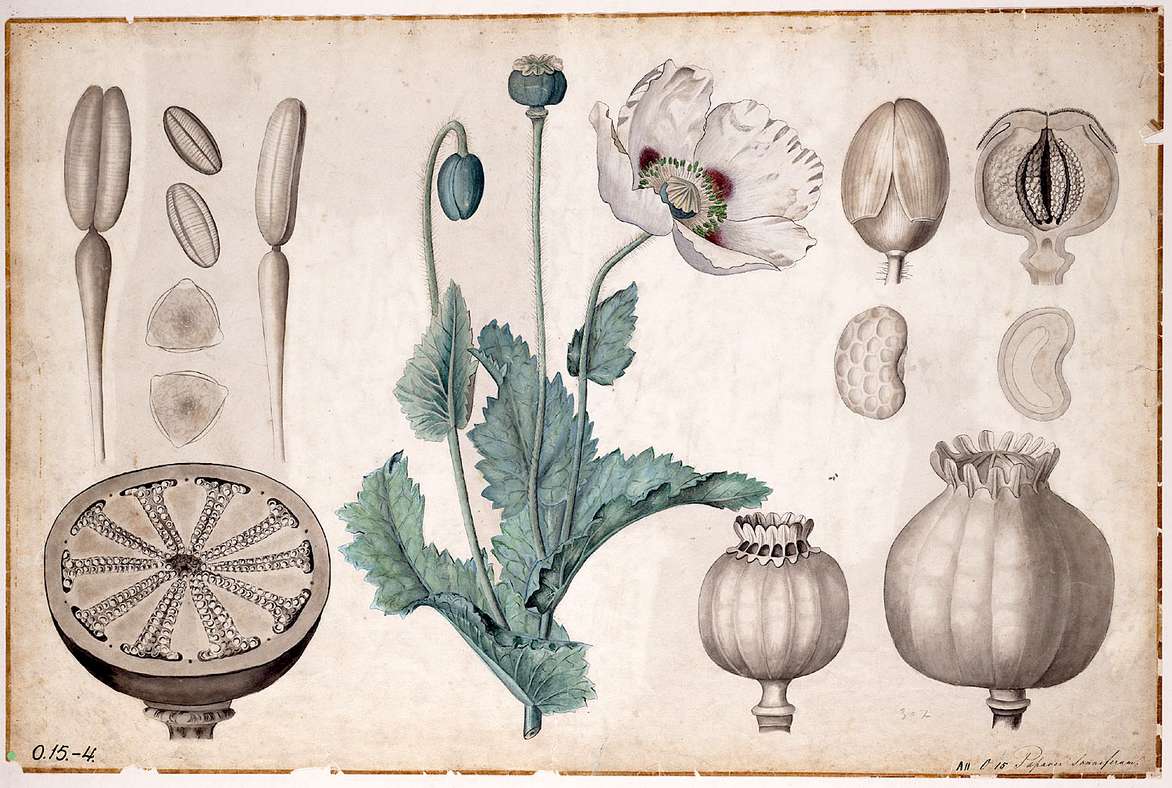
Papaver somniferum – botanical illustration
Annual poppies include several species from the Papaveraceae family, the main ones being:
- Papaver rhoeas, the famous corn poppy
- Papaver somniferum: garden poppy or opium poppy
- Eschscholzia californica, a different genus but from the same family as our poppies. This is the California poppy.
Corn Poppies
Papaver rhoeas or corn poppy, a messicolous flower, has become the emblem of wildflower meadows and natural grasslands. It’s the hairy member of the family: its stems and flower buds are bristly with hairs. We love the lovely contrast between its bright red and the green of surrounding vegetation. Today there are many varieties, particularly from the “Shirley” strain developed by British botanist William Wilks (1843-1923). Thanks to his long and patient work of successive selections and cross-breeding, we can grow corn poppies in pastel colours, single or double. With their unusual colours, pink or white corn poppies are sure to catch every eye. For those who prefer vibrant colours, the Ladybird cultivar (ladybird), aptly named, is spectacular with its vermilion colour and black macules!

Corn poppies or Papaver rhoeas can come in several colours.
Garden Poppies
Papaver somniferum or garden poppy has larger flowers than its cousin the corn poppy. Its foliage is less branched and the robust, hollow stem is glabrous and taller (from 1 m to 1.5 m!). For gardeners, the choice is endless as there’s a very wide range of forms and colours. The petals can be single or multiple, creating peony-flowered varieties (like the Black Peony annual poppy) or resembling carnations (like the bicolour Berries & Cream) and the extraordinary ruffled pompon varieties proudly displayed by the Tallulah Belle Blush cultivar… Petal shapes can be rounded or tattered, like the graceful Pink Fizz and all colours are represented except blue.
After the exuberant or simple corollas, the fruits prolong the show in a more subtle and delicate manner. The ornamental capsules with their subtle, light-changing colours can remain in the garden long after flowering, displaying graceful, ephemeral plant sculptures.

From the simplest to the very double, opium poppies come in many colours.
California Poppies
Eschscholzia californica or California poppies, are the American cousins of our poppies. Smaller, they form rounded, spreading clumps of beautiful, very divided, feathery bluish-green foliage. Their cup-shaped corollas with 4 petals are bright orange in the type species, but many cultivars enrich the “collection”, with colours ranging from creamy white to red, and petals that are more or less double. Moreover, they flower for longer and can become perennial in mild climates. Their difference from European poppies also lies in their fruits: these are long, slender capsules that open along their length to project their countless tiny seeds.
Here too, California poppies will be used to fill empty spaces in the garden. They provide colourful patches alongside thyme, lavender for example, either in contrast or in harmony with mauve and pink cultivars… These flowering cushions work wonders as borders and they can colonise slopes with panache for the wild orange variety, or elegance for the white-cream varieties.
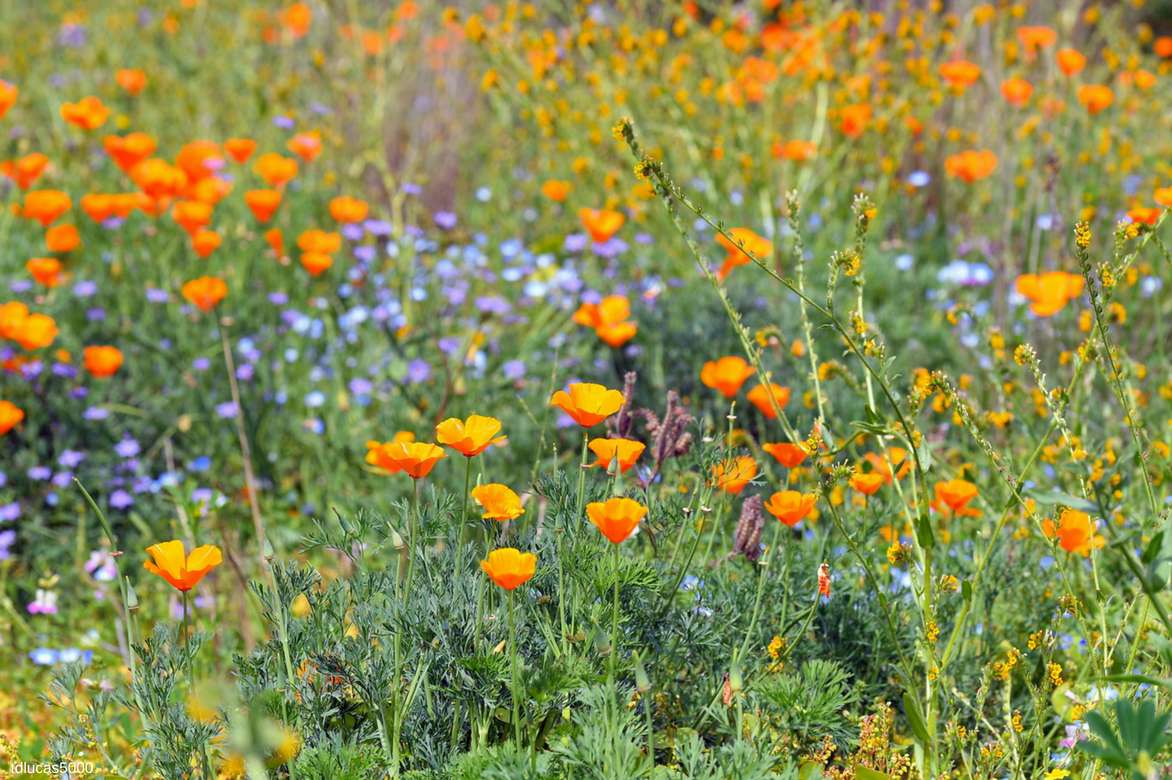
Over the years, California poppies self-seed to form pretty expanses of naturally-styled flowers.
Read also
Oriental Poppies: How to Grow Them?The main varieties of poppies
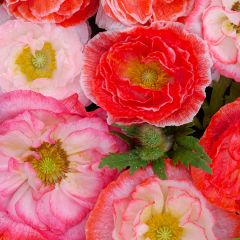
Poppy Falling in Love mix Seeds - Papaver rhoeas
- Flowering time July to September
- Height at maturity 80 cm
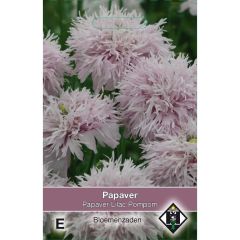
Papaver paeoniflorum Lilac Pompom
- Flowering time July to September
- Height at maturity 90 cm
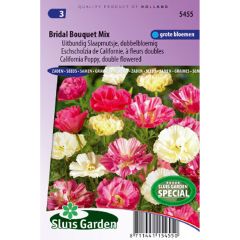
California Poppy Bridal Bouquet Mix Seeds - Eschscholzia californica
- Flowering time July to October
- Height at maturity 25 cm
Discover other Poppy seeds
View all →Available in 1 sizes
Available in 1 sizes
Available in 1 sizes
Available in 1 sizes
Available in 1 sizes
Available in 1 sizes
Available in 1 sizes
Available in 1 sizes
Available in 1 sizes
Available in 1 sizes
Our favourite varieties of annual poppies
[product sku=”83127″ blog_description=”Charming mix of poppies in soft and delicate hues.” template=”listing1″ /]
[product sku=”333″ blog_description=”Original and refined colour for this peony-flowered poppy. Paired with a yellow or orange rose, the contrast is striking… for a more subdued combination, opt for perennial plants or pink roses.” template=”listing1″ /]
[product sku=”356″ blog_description=”California poppy in warm, soft peach tones. Perfect for borders with gentle, luminous colours.” template=”listing1″ /]
Read also
Oriental Poppies: 8 Garden Pairing IdeasVarieties to discover
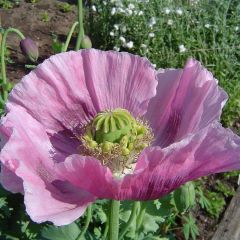
Papaver somniferum nigrum - Poppy Seeds
- Flowering time August, September
- Height at maturity 1 m
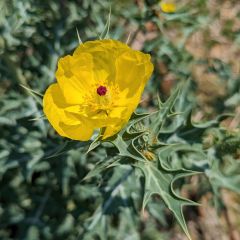
Dicranostigma franchetianum - Eastern Horned Poppy seeds
- Flowering time July to October
- Height at maturity 60 cm
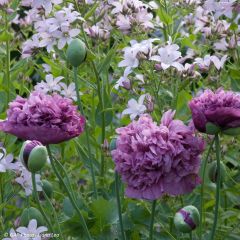
Opium Poppy Purple Peony Seeds - Papaver somniferum
- Flowering time July to September
- Height at maturity 80 cm
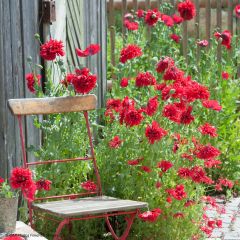
Opium Poppy Red Peony Seeds - Papaver somniferum
- Flowering time July to September
- Height at maturity 90 cm
Sowing annual poppies
Where to sow annual poppies?
Poppies thrive in sunny locations, in well-drained and deep soil to allow their taproot to anchor properly. In any case, it’s important to prepare the soil thoroughly before sowing.
When to sow?
Annual poppies are sown in autumn and early spring, with autumn being ideal. In October, the still-warm soil and autumn rains ensure quick germination, producing seedlings that will have several weeks to establish themselves. By late spring, the now robust plants will produce magnificent flowers.
Sowings in March will result in poppies that flower later. Beyond April, the plants will be weak as they won’t have had enough time to develop sufficient foliage before flowering.
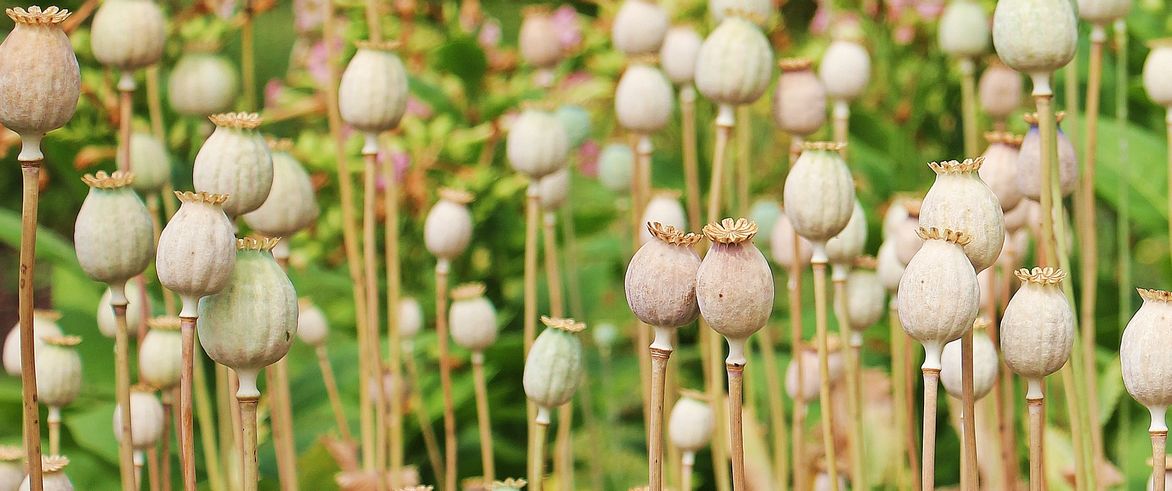
Seed pods of Opium Poppies.
How to sow?
Direct sowing
Before sowing your poppies, a false sowing will help reduce adventive weeds. The step-by-step guide for this technique is detailed in the fact sheet « False sowing, an effective technique to reduce “weeds”.
Here’s a method for sowing your poppy seeds:
- Weed the area where you want to plant your poppies
- Work the soil with a spade to a maximum depth of 10 cm, incorporating sand if your soil is heavy and clay-rich
- Break up the soil with a rake and level it to create a smooth surface
- Sow the seeds by scattering them. The seeds are tiny: for even distribution, mix them with sand
- Lightly firm the soil with the back of a spade, for example, to help the seeds adhere
- Water gently with a fine spray, avoiding runoff that could wash the seeds away
- Keep watering until germination if there’s no rain
Sowing poppies in pots
For a temporary display, poppies can be sown in pots or containers. In this case, choose compact varieties such as California poppies and field poppies. Scatter the seeds in a large pot or container and lightly firm the soil. Thin out overcrowded seedlings, and that’s it! Regular watering is essential as pots dry out quickly.
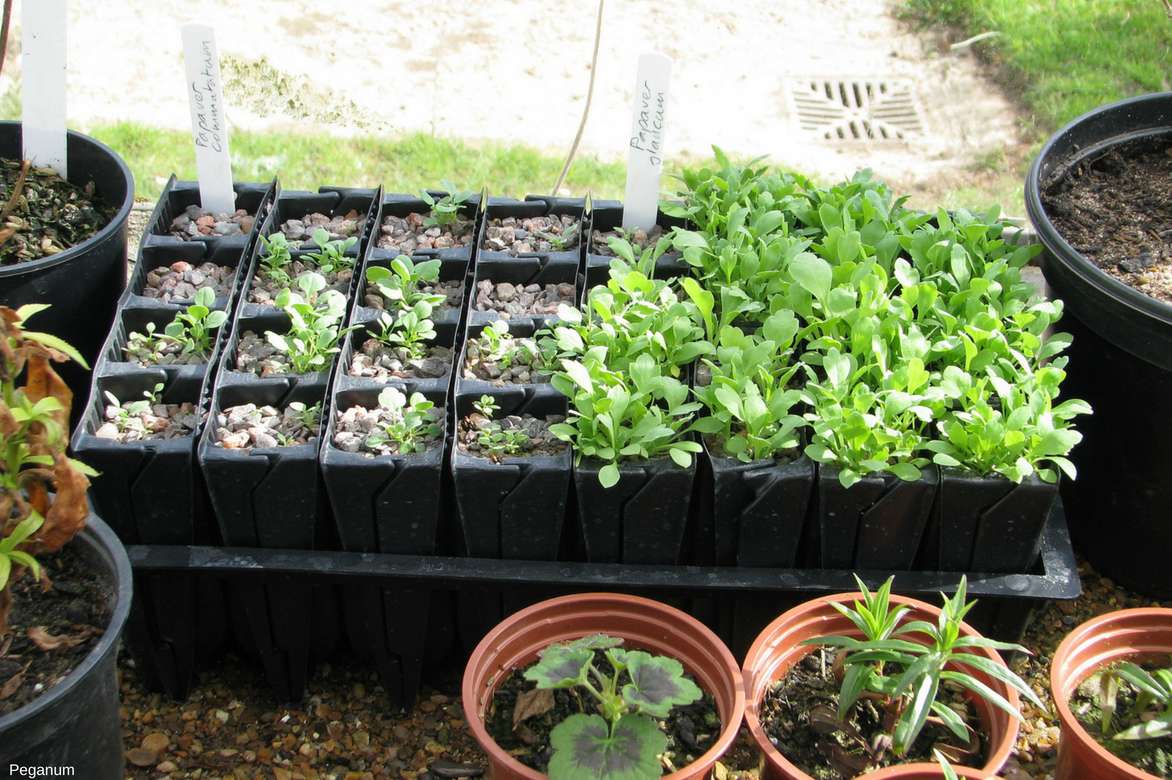
Sowing poppies.
To learn more, check out our tutorial How to sow field poppies?, Gwenaëlle’s advice in How to succeed with annual and perennial poppies?, as well as Virginie’s article explaining how to sow annual seeds in this article.
Maintenance
Annual poppies are trouble-free plants that require very little maintenance. During dry spells, watering will support flowering. Occasional manual weeding prevents any proliferation of adventives. As they self-seed generously, there is a risk of them taking over the garden. Thinning out excess young plants can be done in autumn or the following spring. If needed, cut back faded flowers to prevent seed formation… and create delightful bouquets!
Propagation
Annual plants, poppies multiply by sowing, it’s simply a matter of collecting the seeds when they reach ripeness. As the seeds are very fine, cut the stems carefully and shake the bouquet into a paper bag. Store the seeds in a cool, dry place until the next sowing.
Also read our tutorial How to take cuttings from poppies?
Diseases and Pests
Most annual poppies are endemic and have therefore adapted to the soil climate of our regions. However, aphids are particularly fond of them and an invasion may sometimes devour our tender poppies.
As aphids are a recurring foe, gardeners have developed several control strategies. The simplest is to offer them as prey to their natural predators, such as ladybird or hoverfly larvae, by ensuring these aphid-devouring creatures feel at home in the garden. This means providing them with hiding spots, mating areas, and a pesticide-free environment to complete their life cycle undisturbed!
For tips on keeping our ladybird friends close to our flowers, check out Ingrid’s article: long live relay plants, and Virginie offers further control and prevention advice.
Pairing Poppies in the Garden
In the garden, poppies can be used in multiple ways – to adorn flower beds, dress temporarily vacant open spaces, or bring life to borders for a single year.
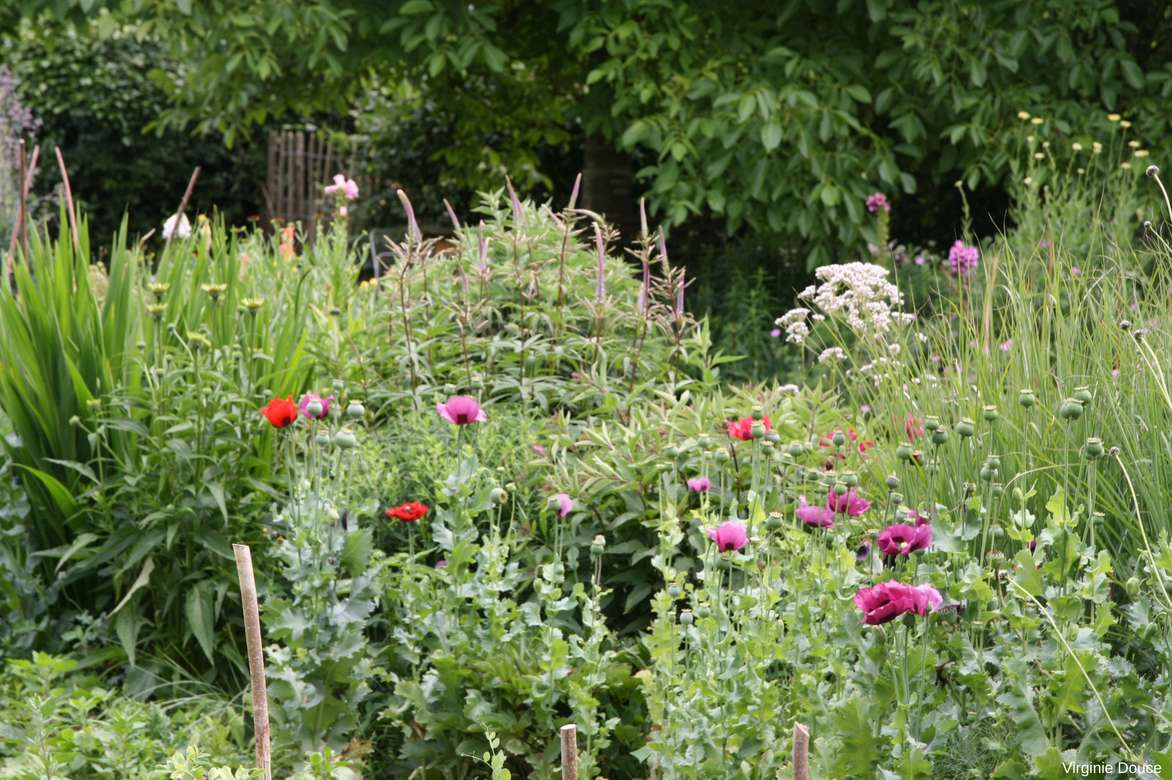

An example of a flower bed combination: Various poppies including Papaver somniferum ‘Nigrum’, Veronicastrum virginicum ‘Fascination’ and Miscanthus sinensis ‘Gracillimus’ (Garden “Citrouilles et Lutin”).
Use poppies at the base of old fruit trees: the flowering of these playful annuals will follow that of the bushes. The poppies will fade as the fruits appear, which will then steal the show.
You can create flowering meadows or natural flower beds: combined with other annuals or mixed with perennials, you’ll enjoy an ever-changing display through the seasons with minimal maintenance. The only limit is your imagination!
Poppies naturally belong in dry gardens. Sow field poppies or single-flowered poppies among bushes of artemisia, convolvulus, santolina and rosemary. Lower-growing plants like thyme, catmint and fleabane also provide the perennial framework of the bed, while ground covers like Lippia nodiflora and Achillea crithmifolia fill the gaps. A gravel mulch will limit adventive germination. Naturalising spring bulbs and self-seeding poppies ensure floral displays from early spring through summer.
Peony-flowered poppies can dress the base of rose bushes. The choice of colours for each plant allows for all combinations: black or purple poppies with pale yellow or orange single roses, punctuated by round-headed alliums for a chic, trendy contrast. Multicoloured poppies in dominant pink and red shades will playfully enliven white or pink roses…
Did you know?
The relaxing properties of California poppies and common poppies are used in traditional pharmacopoeia.
The common poppy is also a bio-indicator plant: it grows on disturbed soils with strong water contrast.
The opium poppy is divided into two varieties: album and nigrum. This refers to the colour of the seeds. White seeds produce poppies very rich in opium. As a result, they are not commercially available. Seeds containing negligible amounts of opium are used, particularly in the production of curry paste.
Black poppy seeds (Papaver somniferum nigrum) are used in cooking, traditionally in Eastern Europe, to decorate and flavour breads, cheeses, or cakes. Poppyseed oil is extracted from pressing these seeds and is used as a binder in oil paint, much like linseed oil.
Useful resources
Discover all our varieties of annual poppies.
The corn poppy is the champion of flowering meadows… The Noé association describes all the benefits of creating a natural flowering meadow in a corner of your garden.
- Subscribe!
- Contents
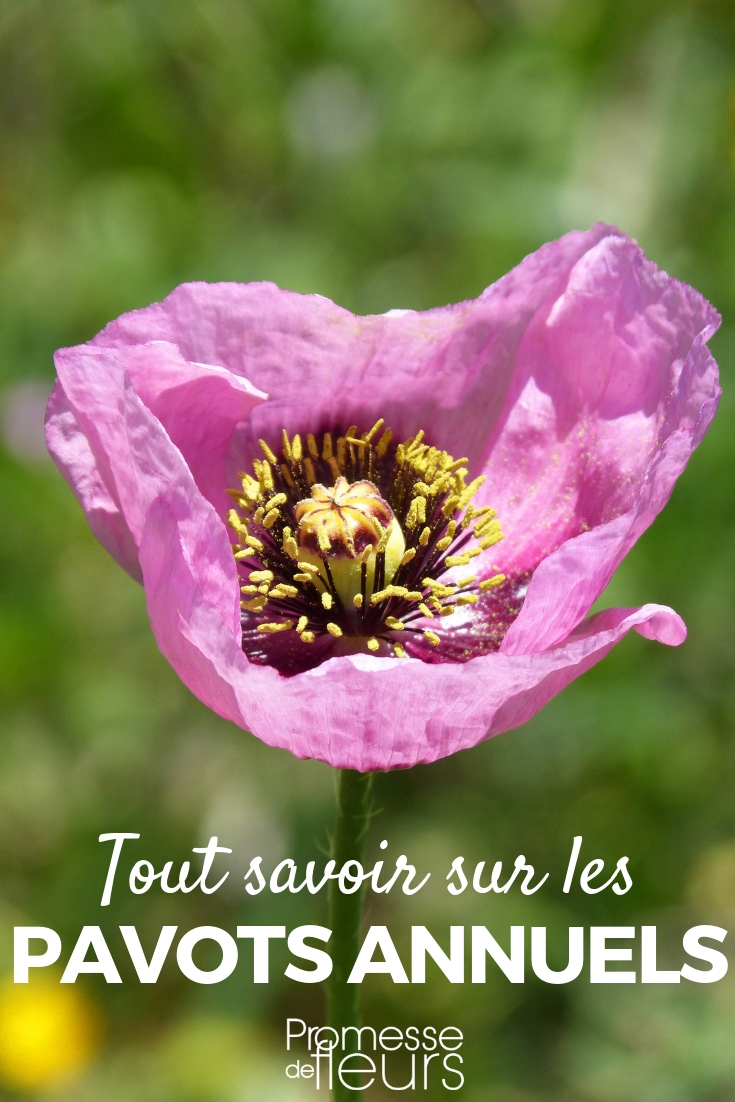


































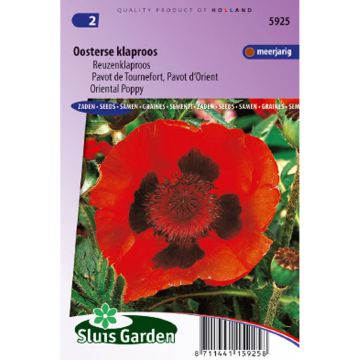


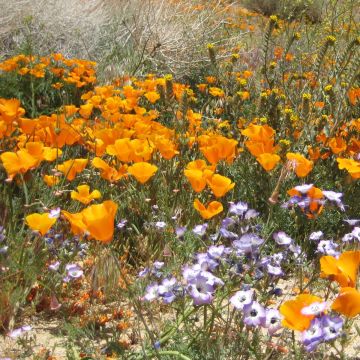
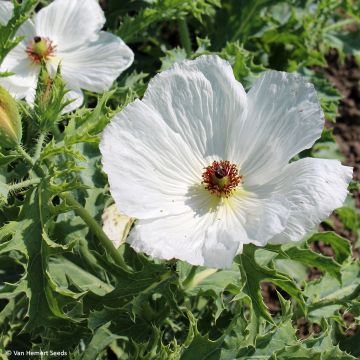

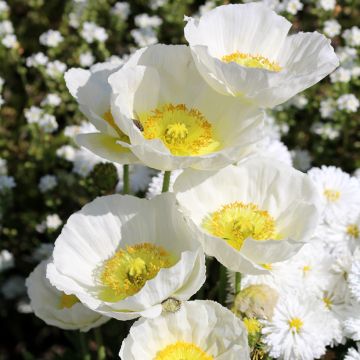
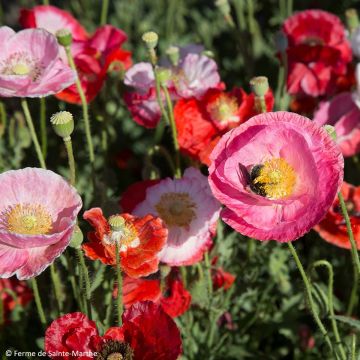
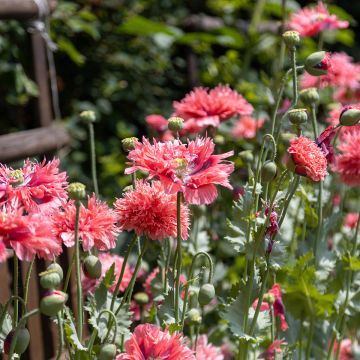
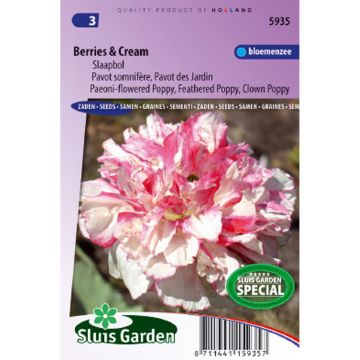
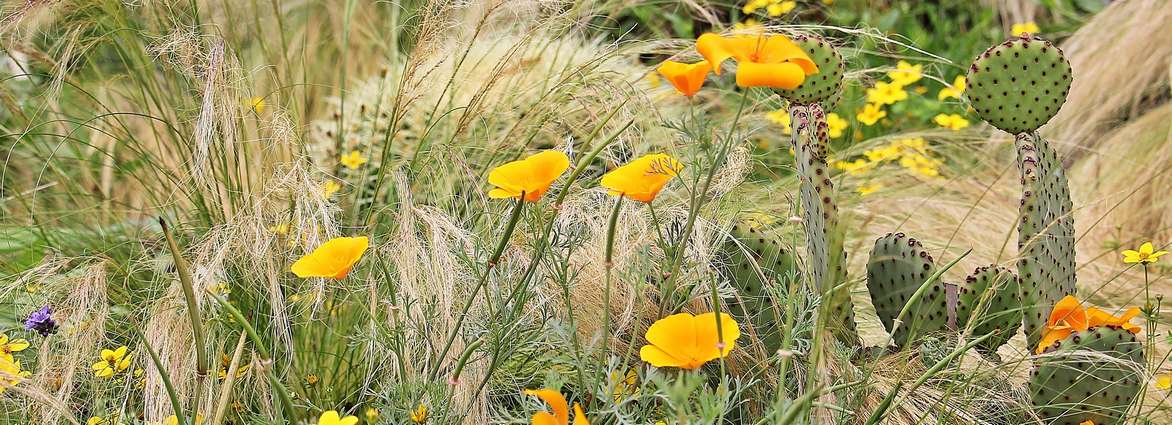
Comments